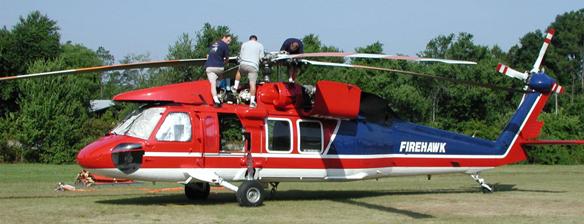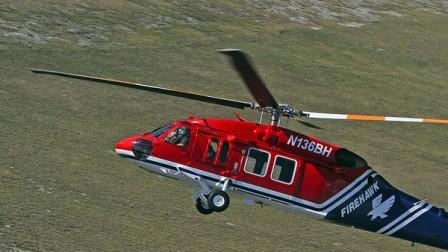
When I was working on the Blackjack Bay Complex in Georgia and Florida in May of 2002 we had a privately-owned Blackhawk helicopter assigned to the fire that was named “Firehawk”, as you can see in the above picture.
The Orlando Sentinel has an interesting article about Firehawk Helicopters Inc., a subsidiary of Brainerd Helicopters of Leesburng, Florida. Here is an excerpt:
Smaller, less-expensive helicopters typically make the initial attack when a wildfire breaks out. Heavy lifters such as a Firehawk, typically hired by the U.S. Forest Service for thousands of dollars an hour, turn out for the biggest, scariest fires.
The Black Hawk is fast, cruising at 160 mph and topping out at nearly 200. At 11,000 pounds empty and twice that loaded, it weighs four times as much as a typical police helicopter. Brainerd’s fuel trucks are labeled “Prey for the Hawk.”
His Black Hawks hoist 900-gallon buckets to unload their water on fires. A few rotorcraft can carry more — but none more safely than the Firehawks. Their seats flex as much as 12 inches to absorb the shock of a crash that could otherwise break a pilot’s back.
“That’s Chuck’s way of doing things,” said George Custer, a Forest Service incident commander. “All contractors want to be safe, but not all of them invest the kind of money that Chuck has invested in his tools.”
Chuck Brainerd had quit yanking timber out of swamps in 1977. The helicopter he had then wasn’t so trustworthy. “I was beginning to feel like every day could be my last.”
He quit transporting heart patients in 1986. “It felt good to help people, but it just wasn’t what I wanted to do.”
He found a better chopper, outfitted it as an airborne firetruck and went to a California blaze. That chaotic first day in September 1987 jarred him. “I thought, ‘Chuck, you’re in over your head.’ ”
Days later, Brainerd managed a difficult drop, soaking a smoldering tree. Ground crews cheered. “I thought, ‘Wow, I hit it.’ Then I was hooked and knew that I wanted to do it for the rest of my life.”
He flew to Yellowstone National Park a year later for the famous inferno that scorched the nation’s psyche and more than one-third of the park’s acreage.
He bought his first Black Hawk in 1995, then another, and then teamed with Brown Helicopters of Pensacola for three more.
All came pre-owned, including one from the Sultan of Brunei with gold-plated door handles still attached, and another from Hong Kong’s harbor patrol with machine-gun mounts still affixed.
Because Black Hawks and replacement parts are hard to get, it can be more challenging for the Brainerds than for the average copter company to keep the fleet in the air.
But Brainerd is a believer in the Army’s choice of aircraft: If the Black Hawk can survive bullet strikes and hard landings, it’s more than able to wage war on wildfires. National Guard units sometimes deploy their Black Hawks to forest fires; Los Angeles County bought two of them for firefighting.
The Brainerds’ copters, now reconditioned, reconfigured and repainted, might sell for $10 million each. It’s hard to say, because few such machines ever come on the market.
Until recently Firehawk Helicopters was the only private company in the country operating Blackhawks. Now, according to the Firehawk Helicopters web site:
Brainerd Helicopters and Brown Helicopters have teamed up.
Now located at Brainerd Helicopters facility in Leesburg, FL are three Sikorsky S-70A Black Hawks, owned by Brown Helicopters. These Black Hawks are going through an extensive inspection process, and are going to be equipped with the same avionics, mission equipment, and fire fighting capabilities as our original two Firehawks. For more information about this important development follow this Link.


Here is a video featuring the Firehawks:

I had the chance to fly with the Firehawks when they were here at the New Orleans Intl Airport after Hurricane Katrina. I flew for almost a month with them, dropping water on structure fires in the New Orleans metro area, fought a couple of wildland fires, raced to the Mississippi coast for a mission and landed at a helispot that Marine One was getting ready to land and told to take off by the Secret Service. These are great guys and truly deserving of the term hero. Miss you guys. Stay safe.
I worked with Chuck as a helicopter manager and then helibase manager when he had the S-58Ts and then Firehawk. He was allways fully professional, a true southern gentleman and a wonderful person. When his aircraft came on to a incident you could count on them being fully ready to go and meeting or exceeding all contract requirements. Despite being old the 58Ts were so clean you could eat off the floor. His crews were there to ensure the job was done with safety and correctly. He always ensured that the customer was fully served and often went beyond the requirements of the contract to make sure we were. In Oregon he flew his then new Firehawk on it’s first western fire assignment on to a large helibase I was managing and it seemed like all flight operations ceased as pilots flocked over to look at it. Everyone loved the paint job.